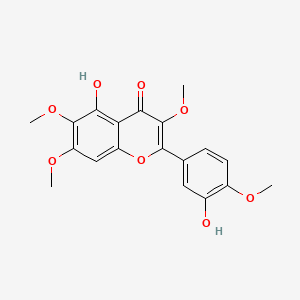| MeSH term | MeSH ID | Detail |
|---|---|---|
| Bronchial Spasm | D001986 | 18 associated lipids |
| Carcinoma, Non-Small-Cell Lung | D002289 | 72 associated lipids |
| Glioma | D005910 | 112 associated lipids |
| Prostatic Neoplasms | D011471 | 126 associated lipids |
| Carcinoma, Hepatocellular | D006528 | 140 associated lipids |
| Colonic Neoplasms | D003110 | 161 associated lipids |
| Lung Neoplasms | D008175 | 171 associated lipids |
Casticin
Casticin is a lipid of Polyketides (PK) class. The involved functions are known as Ligand Binding. The related lipids are linoleates.
Cross Reference
Introduction
To understand associated biological information of Casticin, we collected biological information of abnormalities, associated pathways, cellular/molecular locations, biological functions, related genes/proteins, lipids and common seen animal/experimental models with organized paragraphs from literatures.
What diseases are associated with Casticin?
There are no associated biomedical information in the current reference collection.
Possible diseases from mapped MeSH terms on references
We collected disease MeSH terms mapped to the references associated with Casticin
PubChem Associated disorders and diseases
What pathways are associated with Casticin
There are no associated biomedical information in the current reference collection.
PubChem Biomolecular Interactions and Pathways
Link to PubChem Biomolecular Interactions and PathwaysWhat cellular locations are associated with Casticin?
There are no associated biomedical information in the current reference collection.
What functions are associated with Casticin?
Related references are published most in these journals:
| Function | Cross reference | Weighted score | Related literatures |
|---|
What lipids are associated with Casticin?
Related references are published most in these journals:
| Lipid concept | Cross reference | Weighted score | Related literatures |
|---|
What genes are associated with Casticin?
There are no associated biomedical information in the current reference collection.
What common seen animal models are associated with Casticin?
There are no associated biomedical information in the current reference collection.
NCBI Entrez Crosslinks
All references with Casticin
Download all related citations| Authors | Title | Published | Journal | PubMed Link |
|---|---|---|---|---|
| Liu F et al. | Casticin suppresses self-renewal and invasion of lung cancer stem-like cells from A549 cells through down-regulation of pAkt. | 2014 | Acta Biochim. Biophys. Sin. (Shanghai) | pmid:24247269 |
| Liu E et al. | Casticin induces human glioma cell death through apoptosis and mitotic arrest. | 2013 | Cell. Physiol. Biochem. | pmid:23816816 |
| Zhou Y et al. | Casticin induces caspase-mediated apoptosis via activation of mitochondrial pathway and upregulation of DR5 in human lung cancer cells. | 2013 | Asian Pac J Trop Med | pmid:23608376 |
| Tang SY et al. | Casticin, a flavonoid, potentiates TRAIL-induced apoptosis through modulation of anti-apoptotic proteins and death receptor 5 in colon cancer cells. | 2013 | Oncol. Rep. | pmid:23135489 |
| He L et al. | Casticin induces growth suppression and cell cycle arrest through activation of FOXO3a in hepatocellular carcinoma. | 2013 | Oncol. Rep. | pmid:23064420 |
| Zhou Y et al. | Casticin potentiates TRAIL-induced apoptosis of gastric cancer cells through endoplasmic reticulum stress. | 2013 | PLoS ONE | pmid:23536831 |
| Lee C et al. | Anti-inflammatory constituents from the fruits of Vitex rotundifolia. | 2013 | Bioorg. Med. Chem. Lett. | pmid:24035341 |
| Kikuchi H et al. | Involvement of histone H3 phosphorylation through p38 MAPK pathway activation in casticin-induced cytocidal effects against the human promyelocytic cell line HL-60. | 2013 | Int. J. Oncol. | pmid:24064676 |
| Kikuchi H et al. | Cytotoxicity of Vitex agnus-castus fruit extract and its major component, casticin, correlates with differentiation status in leukemia cell lines. | 2013 | Int. J. Oncol. | pmid:24126491 |
| Righeschi C et al. | Microarray-based mRNA expression profiling of leukemia cells treated with the flavonoid, casticin. | 2012 May-Jun | Cancer Genomics Proteomics | pmid:22593249 |
| Kim HJ and Jin CY | Stem cells in drug screening for neurodegenerative disease. | 2012 | Korean J. Physiol. Pharmacol. | pmid:22416213 |
| Lee SM et al. | Vascular protective role of vitexicarpin isolated from Vitex rotundifolia in human umbilical vein endothelial cells. | 2012 | Inflammation | pmid:21614554 |
| Xu J et al. | Quantitative determination and pharmacokinetic study of casticin in rat plasma by liquid chromatography-mass spectrometry. | 2012 | J Pharm Biomed Anal | pmid:22177414 |
| Zeng F et al. | Induction of apoptosis by casticin in cervical cancer cells: reactive oxygen species-dependent sustained activation of Jun N-terminal kinase. | 2012 | Acta Biochim. Biophys. Sin. (Shanghai) | pmid:22427461 |
| Weathers PJ and Towler MJ | The flavonoids casticin and artemetin are poorly extracted and are unstable in an Artemisia annua tea infusion. | 2012 | Planta Med. | pmid:22673829 |
| Ling Y et al. | Metabolism studies of casticin in rats using HPLC-ESI-MS(n). | 2012 | Biomed. Chromatogr. | pmid:22407499 |
| Januar HI et al. | In silico study of fucoxanthin as a tumor cytotoxic agent. | 2012 | J Pharm Bioallied Sci | pmid:22368399 |
| Meng FM et al. | Vitexicarpin induces apoptosis in human prostate carcinoma PC-3 cells through G2/M phase arrest. | 2012 | Asian Pac. J. Cancer Prev. | pmid:23464460 |
| Feng X et al. | Drug screening study using glioma stem-like cells. | 2012 | Mol Med Rep | pmid:22923060 |
| Su CC et al. | An investigation into the cytotoxic effects of 13-acetoxysarcocrassolide from the soft coral Sarcophyton crassocaule on bladder cancer cells. | 2011 | Mar Drugs | pmid:22363243 |
